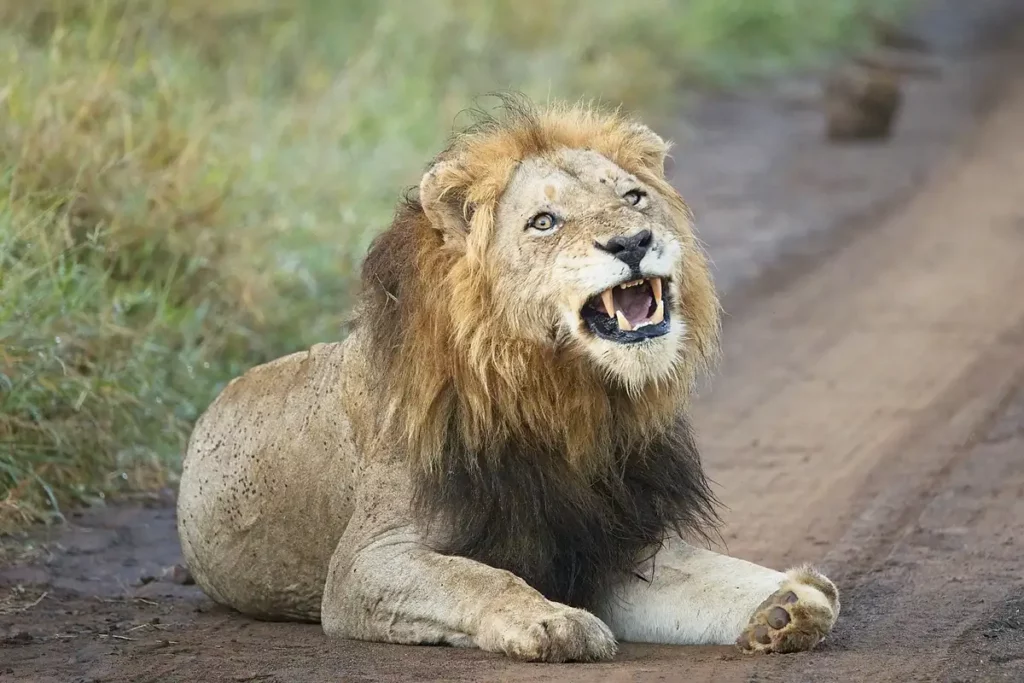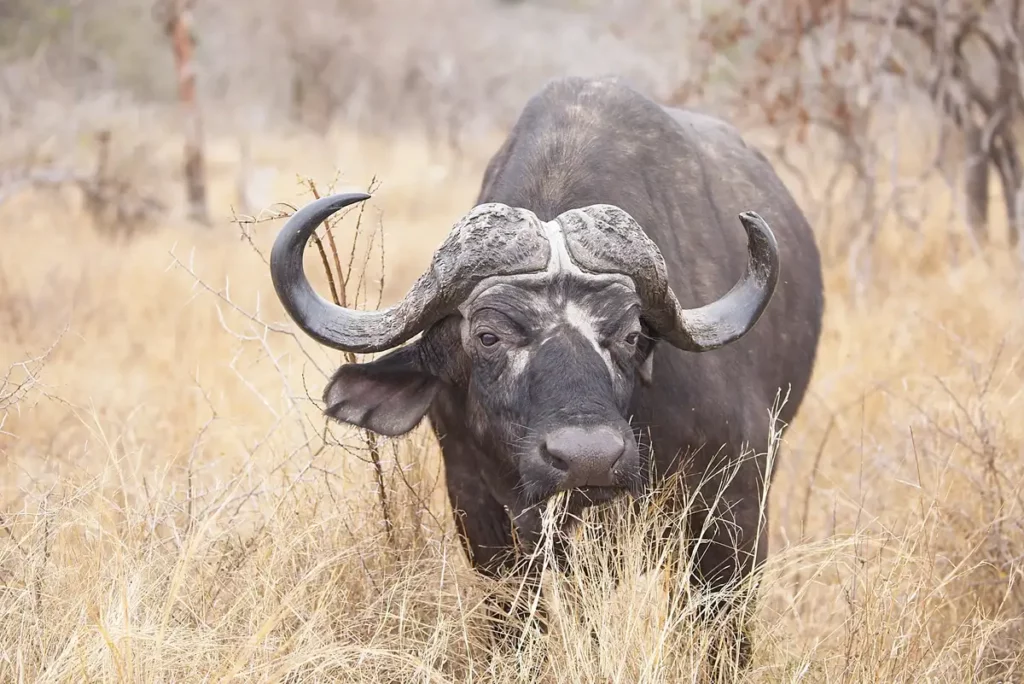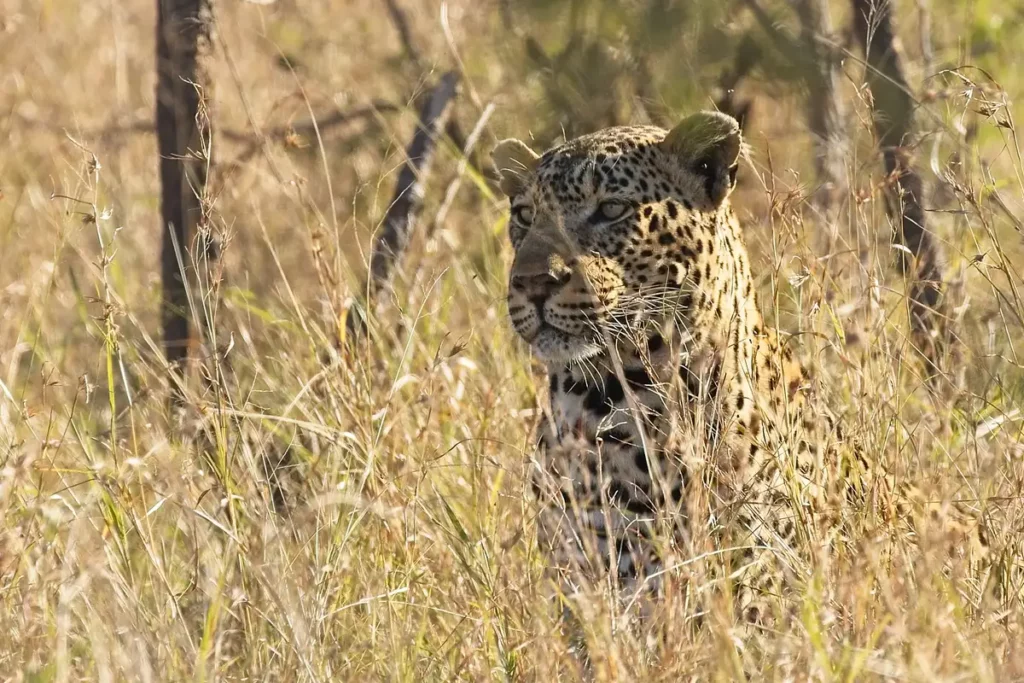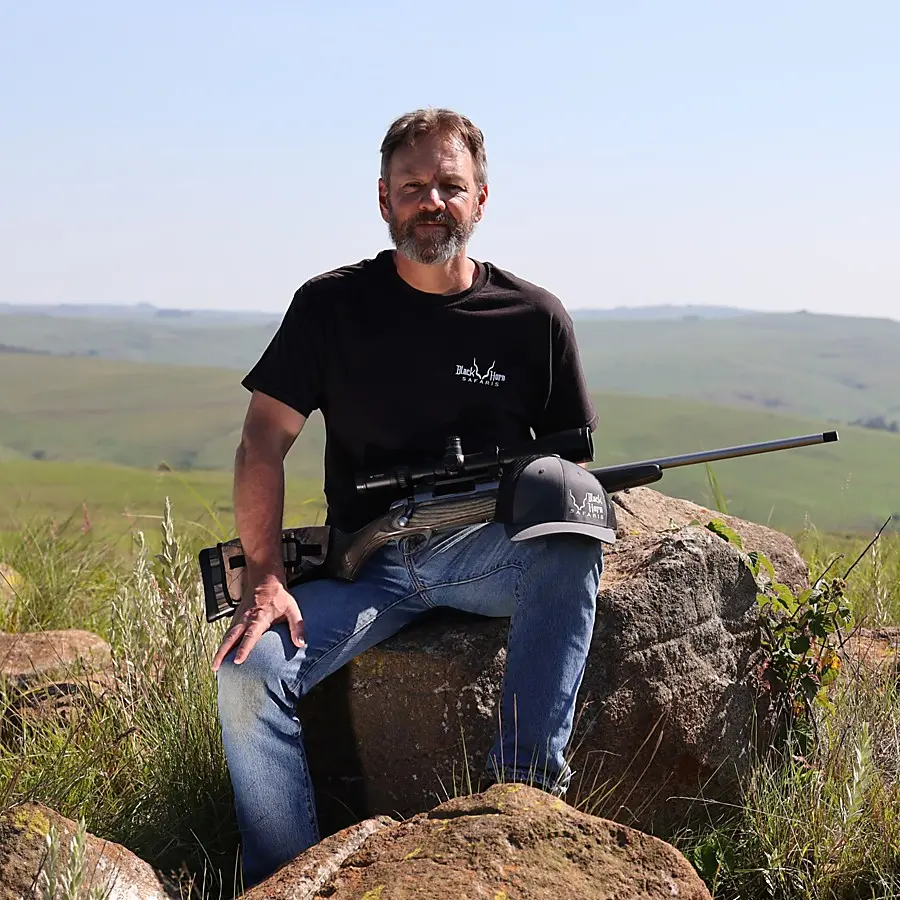Hunting Dangerous Game is at the pinnacle of the sport. It is an adrenaline packed adventure into the heart of Africa where you will face the ultimate challenge of your skills, courage, and endurance. It is the pursuit of some of the most awe inspiring animals on earth. These are the legendary Big Five, and they will test your resolve like no other quarry. Experience the thrill of tracking, stalking, and harvesting these animals in their natural habitats. You will also contribute to the conservation and management of these wildlife resources, as well as to the local communities that inhabit their territories. Tackling dangerous game is not for everyone. It requires a high level of physical fitness, mental preparedness, and ethical conviction. If you are looking for the ultimate adventure that will push you to your limits and beyond, then a Dangerous Game hunt in South Africa is that challenge.




The Big Five & Dangerous Seven
Africa is home to some of the most cunning and dangerous animals on the planet. Among them are the Dangerous Seven: Elephant, Lion, Leopard, Rhino, Cape Buffalo, Crocodile and Hippo. These are the most revered and respected species on the continent.
Each of these formidable animals has its own unique character traits and adaptations that make them respected opponents. These large pachiderms are the biggest and strongest land mammals, capable of crushing anything in their path. The Lion is the king of the bushveld, operating in cohesive prides and using their teeth, claws and incredible power to bring down their prey. The Leopardo is the master of stealth, cunning and camouflage climbing trees and hiding in the shadows to ambush their victims. Rhinos are the armored tanks of Africa, charging at full speed with their horns lowered into any confrontation. Buffalo are the most malevolent and unpredictable, often turning on predators and goring them with their horns. The Crocodile is an ancient predator of murky waters, lurking beneath the surface and snapping their jaws shut on anything that comes close. Hippos are the giants of the river, but also the most aggressive and territorial, defending their territories with their gaping mouths and long tusks.
These animals are deadly because of their physical size, ferocity and power, but also because of their intellect and behavior. They all have a built in sixth sense for danger, they use the environment to their advantage, and sometimes can be vindictive. They are unpredictable, changing their demeanor and attitude depending on the situation.
These animals are not only a threat to man, but also to each other. They compete for food, water, territories and mates, often resulting in fierce battles and deadly injuries. The balance of power among these animals is constantly shifting, depending on factors such as season, climate, competition and available natural resources.
Elephant Hunting
Collecting a big Tusker is one of the most challenging and rewarding forms of Safari in Africa. It requires a high level of skill, patience and nerves of steel to pursue these giants. It has been said that you kill a good Bull with your feet, this is often true. The hunter must be able to endure long marches, and read the signs such as tracks, dung and broken branches and listen for the sounds of feeding. He must also be able to anticipate the elephant’s movements and behavior, and to approach it from downwind and with stealth. Be prepared for a close encounter, the shooting distance is usually within 40 yards. The thrill of facing such an imposing and intelligent beast is unmatched by any other form of hunting.
Note that taking one of these giants is not for everyone. It is a serious undertaking that requires respect for the animal and its habitat. The hunter must follow ethical practices, such as only taking mature bulls that are past their breeding prime, avoiding females and young, and ensuring a quick and humane kill. Elephant culling is a conservation tool that helps to maintain healthy populations and habitats, as well as providing benefits to local communities and wildlife authorities.
Cape Buffalo Hunting
A Safari for these bovines is one of the most thrilling and rewarding adventures you can do. No matter whether they are called Mbogo, Nyati or Black Death wherever you may be pursuing them, these unpredictable animals are renowned for their strength and resilience. They can weigh up to 900 kg and have horns that can span over 50 inches.
Probably the best method to take a Buffalo is on foot, following their tracks and dung pats through the bush. When you finally meet up with them it will more often than not be at close range in thick cover. Buffalo are often the first member of Dangerous Game that the hunter will take on.
Lion Hunting
These large cats can be challenging and thrilling at the same time requiring patience and courage. There are two main methods of obtaining one of these cats: baiting and tracking.
Baiting involves luring a lion to a specific location by using the carcass of another animal as bait. The hunter then waits in a concealed position, such as a blind or a tree stand- Machan, and shoots the lion when it comes to feed on the carcass. This method can be effective for older or injured big cats that are less active and more likely to scavenge.
Tracking, often employed in the Kalahari regions, and involves following the tracks and signs of until it is located. The hunter then stalks the pride carefully, avoiding detection by using cover and wind direction, and tries to get within shooting range.
Both methods of pursuing shumba involve a mind game between the hunter and the prey. These large cats are intelligent and cunning predators that can sense danger and evade hunters. They can also turn the tables and become the hunters themselves, ambushing and charging the hunters.
Leopard Hunting
Leopards are one of the most elusive and cunning predators in Africa. Hunting them requires a lot of planning and strategy, as well as patience and skill. There are two main methods of obtaining Ingwe: baiting or using dogs.
Baiting involves hanging the carcass of an animal, such as an impala or a warthog, from a tree, and waiting for a big tom to come and feed on it. The hunter then sets up a blind nearby, where he can observe the carcass and wait for the right moment to shoot. This method can take several days or weeks, depending on the abundance and movement of spotted cats in the area. This is a popular method because it allows the hunter to select a mature tom and avoid shooting females or young ones.
Both methods of pursuit have their pros and cons, but they both offer an unforgettable experience for any hunter who wants to test his skills and nerves against this magnificent cat in Southern Africa.
Rhino Hunting (Rare)
The most common form of White Rhino hunt today is the Green hunt. Green hunting involves the hunter paying to dart the Rhino. The hunter obtains a photograph with the Rhino while the benefit to conservation is that the animal can be treated for any injuries, have his horn filed down, or even relocated to a new territory.

Hippo Hunting
Hippo are dangerous animals and deadly form of sport that requires skill and patience. There are two main methods of pursuing them: stalking from the shores. Stalking involves following the tracks on foot and trying to get close enough for a shot. stalking from the shores involves waiting for a big bull to emerge from the water and shooting from a reasonable distance.
One of the most exciting ways to pursue them is by doing an early morning stalk on foot. This involves waking up before dawn and tracking their movements from the previous night. Hippos usually leave the water at night to graze on land, and return to the water before sunrise. By following their trails, hunters can find and encounter them before they reach the water.
This method also has its risks and challenges. They are aggressive and unpredictable animals that can charge at any sign of threat. They can run faster than humans and have powerful jaws that can crush bones.
Another challenge of these animals is judging the trophy size. They have large heads that can weigh up to 500 kg, but their bodies are mostly submerged in water. Hunters need to look for certain features that indicate a large bull, such as the size and shape of the ears, eyes, nostrils and tusks. A big bull will have large ears that stand out from the head, small eyes that are close together, wide nostrils that flare outwards and long thick tusks that protrude from the mouth.
Crocodile Hunting
Crocodiles are among the most ancient and intelligent predators on Earth. They have evolved over millions of years to survive in various habitats and prey on different animals.
One of the most common methods of pursuing these scaly creatures is stalking from the river/lake shores. This involves finding a suitable spot near a river, lake, or swamp that they are known to frequent, and waiting patiently for one to emerge from the water or bask on the bank. The hunter must be very quiet and still, as crocodiles have a keen sense of hearing and smell, and can easily detect vibrations. The hunter must also be careful not to get too close to the water’s edge, as they can launch themselves out of the water with great speed and force.
The best time to pursue them is during the dry season, when they tend to congregate near water sources and are more active during the day. The hunter should aim for the brain or neck, as these are the most vulnerable parts of its body. A powerful rifle is recommended, as they have thick, tough skin.
Rifles and Calibers for a Dangerous Game Hunt
For pursuing dangerous game animals, the choice of the rifle hunting cartridge is crucial. Reliability, along with stopping power and accuracy, are some of the most important considerations. There are a number of excellent options to choose from, each with its own unique advantages for a dangerous game trip.
The .375 H&H Magnum is one of the most famous and enduringly successful dangerous game cartridges. Developed in 1912 by British gunmaking firm Holland & Holland, it can deliver 300-grain bullets at 2,500 fps (feet per second), producing about 4,200 ft-lbs (foot pounds) of energy. Its flat trajectory makes it an excellent choice for targeting a variety of game, including cats, Waterbuck, Kudu and Eland.
The .458 Winchester Magnum offers more stopping power than the .375 H&H, making it an excellent choice for larger and more aggressive dangerous game. Introduced in 1956, it was designed to provide the performance of the .450 Nitro Express and .470 Nitro Express in a more affordable, bolt-action platform. It sometimes lacks penetration but can be a good choice with the right ammunition choice, delivering a 510-grain bullet at speeds of around 2,130 fps.
The .458 Lott and 460 Weatherby, deliver even more velocity and energy than the .458 Winchester Magnum, these are dedicated cartridges for hunting dangerous game in Africa. They have the power to take down even the largest and most dangerous animals, making them a popular choice among experienced guides.
The .416 Rigby/Remington is another potent choice for dangerous game. Its larger .416 caliber bullets deliver more stopping power, which can be crucial when facing aggressive game. The .470 Nitro Express and .500 Nitro Express are revered among dangerous game hunters for their exceptional stopping power and reliability. These heavy-hitting rounds are designed for close-range encounters with dangerous game.
The Experience of Dangerous Game in Africa
One of the most exciting and challenging forms of Safari is pursuing Africa’s dangerous game. These animals are not only formidable prey, but also inhabit diverse and stunning environments. A dangerous game trip offers the hunter a chance to explore the range of habitats that the continent has to offer. Each of these landscapes has its own beauty, challenges and rewards for the hunter.
Stalking dangerous game on the African continent is a thrilling adventure that exposes the hunter to varied landscapes and wildlife. It is a challenge that demands respect for the animals and the environment. It is an experience that will leave the hunter with lasting memories and stories.
Conservation Efforts – Ethical and Responsible Safari
While pursuing dangerous game may be controversial, it does also contribute to conservation efforts. The revenue generated from hunting permits and fees is used to fund wildlife conservation and protect endangered species.
Responsible practices can help to maintain healthy ecosystems and prevent overpopulation of big game animals. Most outfitters adhere to strict codes of ethics and sustainability guidelines to ensure that their activities have a positive impact on the environment.
CITES is the Convention on International Trade in Endangered Species of Wild Fauna and Flora, which aims to protect wildlife from overexploitation and illegal trade.
Professional Hunters in Africa and Their Expertise
A professional hunter is someone who has been trained and certified to guide and assist hunters in all situations. They have extensive knowledge of the concession areas, the wildlife, the laws and regulations, and the best techniques for obtaining the best animals.
These guides are not only experts in the game animals, but also in conservation. They respect the game they hunt and the environment they operate in. They follow the principles of fair chase and sustainable use of natural resources. They also teach their clients how to hunt responsibly, while ensuring their safety and enjoyment.
There are multiple benefits to hiring a guide, you will benefit from their expertise, experience and passion for the stalk. You will learn new techniques, experience new areas, and create lasting memories.
Factors Influencing Price of a Hunt in Africa
The length or duration of the trip: The length of the hunt is an important consideration as it could potentially impact success. For the predators such as Leo and Leopard you should set aside at least 14 days. Most dangerous game hunters would like to be involved in the whole process and it requires time to choose sites, harvest the bait animal and hang the carcass. Both cat species have large territories to cover and may take a while to discover the carcass before they feed.
Buff can be collected on a relatively short 7 day hunt.
Elephant can require a longer hunt as time is needed to cover the hunting area looking for huge Bull tracks. Because herds travel over extensive areas, it may be a few days before a big bull comes into the area.
The country or area: Certain animal species are only available a particular country or concession examples are Giant/Lord Derby Eland in Cameroon, Black Wildebeest, Bontebok and Blesbok in South Africa and Namibia. Some countries have outstanding areas for certain Big 5 species such as South Africa, Zimbabwe and Mozambique.
Dangerous Game Hunts, Prices and Packages
Elephant – Expect to hunt a bull with tusks weighing between 30 and 50 pounds per side. This is normally a 10 to 21 day trip. Prices vary from $ 30- 45 000 depending on the area hunted. Note that most concessions have an additional charge for tusks weighing over 50 pounds per tusk.
Lion – Prices for a good mane vary from $ 9000 to $ 20 000 depending on the area hunted and quality of manes available. While hunts for captive bred animals are normally cheaper the hunter will not be getting the full experience. This is normally a 14 day hunt.
Leopard – Prices are from $ 25 000 to $ 30 000 depending on the area. Good quality toms take hard work and luck. This is normally a 14 day hunting experience.
Cape Buffalo – A 7 day package for a Buff will cost $ 13 350. This hunt package is ideal to combine with a plains game hunt for Sable antelope, Kudu and Roan Antelope.
Trophy Quality Animals
Trophy selection is an important aspect of hunting, as it affects not only the price but also the experience. Trophy selection refers to the process of choosing which animal to hunt, based on its characteristics and location. Selection can be influenced by personal preferences, ethical considerations and conservation. Some hunters may follow strict criteria for selecting their animals, such as age, size, or shape, while others may be more flexible or opportunistic when hunting.
Trophy selection can have a significant impact on the experience, as it determines the level of challenge, satisfaction, and reward that the hunter may encounter. Pursuing a rare and elusive animal in a vast and rugged terrain may require more skill. Taking an animal that contributes to the conservation of its species or habitat may offer more meaning and value.
However, quality is not the only or ultimate goal of a trip to Africa. Quality should not overshadow the enjoyment and experience of the hunt itself. Trophy quality should not compromise the ethics and sustainability of the hunt either. Quality should be balanced with other aspects of the hunt, such as fair chase, respect for nature, and conservation.
Hunting Methods
Some of the most common hunting methods are rifle, bow hunting, handgun, and muzzleloader. Each method has its own unique characteristics, depending on the hunter’s preferences, skills and desired species.
Certain big 5 animals have limitations on how they may be hunted and minimum equipment standards required.
Conclusion:
Dangerous game on an African hunting Safari is an exhilarating and unforgettable experience for those who seek the ultimate thrill and adventure. It requires careful planning, preparation and the guidance of hunting outfitters and professional guides who know the terrain, the game species and the risks involved.
References
- Title: Ethics and Challenges in Dangerous Game Hunting: A Case Study of African Safaris Author: Roberts, D. J. Journal: Journal of Wildlife Ethics Year: 2022
- Title: Managing Risk and Conservation: The Role of Dangerous Game Hunting in African Wildlife Management Author: Williams, M. K., & Ndlovu, T. Journal: African Journal of Ecology and Conservation Year: 2023
- Title: Perceptions and Experiences of Hunters and Communities in Dangerous Game Hunting Areas of Africa Author: Smith, J. R., & Mabaso, N. Journal: Human-Wildlife Interaction Journal Year: 2021
FAQ’s Frequently asked Questions
What is a dangerous game hunt?
A dangerous game hunt is a hunt for any animal that has the capability of killing or seriously injuring the hunter. These animals include the Big 5 – Elephant, Rhino, Lion Leopard and Cape Buffalo as well as Crocodile and Hippo. While it is true that most of Africa’s animals can harm you if not treated with respect these animals can be aggressive and vindictive and can easily claim the hunters life.
What is dangerous seven hunting?
The Dangerous seven are made up of the Big 5, Elephant, Rhino, Lion, Leopard and Cape Buffalo and additionally include Nile Crocodile and Hippo. Africa is home to some of the most cunning and deadly animals on the planet. These are the most revered and respected game species on the continent.
What is the best rifle/caliber for dangerous game?
The best all round rifle caliber for hunting dangerous game is the .416 Rigby/Remington. Its larger .416 caliber bullets deliver more stopping power, and better penetration which can be crucial when facing large and aggressive game.

Adrian Anderson first obtained his Professional Hunters license in 1991. He is a Big Five and Dangerous Game licensed Professional Hunter and Hunting Outfitter. He has a tremendous love for wildlife and the African bush and enjoys sharing his knowledge with the hunting clients that he guides. Guiding hunters in Africa’s wild places is a passion and seeing them succeed with their goals brings satisfaction. With knowledge of the Safari industry built up over 32 years he is well qualified to give guidance to his hunting clients.
